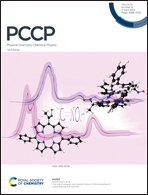The evolution of anionic nanoclusters at the electrode interface in water-in-salt electrolytes†
Abstract
Water-in-salt electrolytes (WiSEs) have attracted extensive attention as promising alternatives to organic electrolytes. The limited electrochemical stability windows (ESWs) of aqueous electrolytes are significantly widened by WiSEs. However, the actual ESWs are lower than predicted as the interphase with WiSEs is not as stable as the solid electrolyte interphase (SEI) in conventional lithium-ion batteries. Therefore, identifying the interface state in WiSEs is vital to understanding their electrochemical behavior. Here, the structure of the lithium bis(trifluoromethane sulfonyl)imide (LiTFSI) electrolyte near the interface of the carbon electrode (Ketjen black) was evaluated by experimental methods (neutron diffraction, Raman, and nuclear magnetic resonance spectroscopy) and molecular dynamics (MD) simulations. The results reveal that the introduction of carbon electrodes increases the size of the anionic nanoclusters and enhances the microphase separation at the interface. The MD simulations show that cation–π interactions are responsible for the evolution of anionic nanoclusters at the electrode interface. Moreover, lower charge transfer resistance is achieved at carbon-based electrodes due to the specific interface state. Our findings provide a strategy for introducing cation–π interactions between electrodes and electrolytes to improve the electrochemical performance.

- This article is part of the themed collection: 2023 PCCP HOT Articles


 Please wait while we load your content...
Please wait while we load your content...